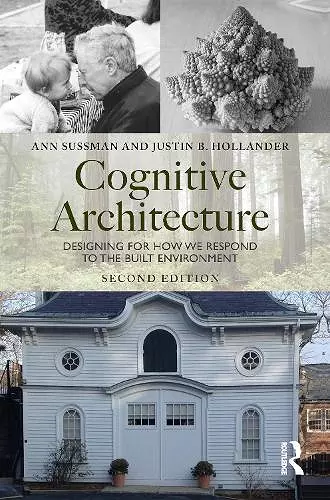Cognitive Architecture
Designing for How We Respond to the Built Environment
Justin Hollander author Ann Sussman author
Format:Paperback
Publisher:Taylor & Francis Ltd
Published:13th Jul '21
Currently unavailable, and unfortunately no date known when it will be back
This paperback is available in another edition too:
- Hardback£145.00(9780367468606)

In this expanded second edition of Cognitive Architecture, the authors review new findings in psychology and neuroscience to help architects and planners better understand their clients as the sophisticated mammals they are, arriving in the world with built-in responses to the environment. Discussing key biometric tools to help designers ‘see’ subliminal human behaviors and suggesting new ways to analyze designs before they are built, this new edition brings readers up-to-date on scientific tools relevant for assessing architecture and the human experience of the built environment.
The new edition includes:
- Over 100 full color photographs and drawings to illustrate key concepts.
- A new chapter on using biometrics to understand the human experience of place.
- A conclusion describing how the book’s propositions reframe the history of modern architecture.
A compelling read for students, professionals, and the general public, Cognitive Architecture takes an inside-out approach to design, arguing that the more we understand human behavior, the better we can design and plan for it.
"At a time where architecture is all about spectacle and "wow effects", [the authors] remind us in Cognitive Architecture that buildings and cities profoundly affect our lives. Design impacts our senses, our psyche and our disposition, drawing on our history, our evolution as a species. The book brings us back to fundamentals, insisting that architectural design must consider and respond to our basic sensibilities, and as such can be either very positive or detrimental to our well-being. It returns architectural discourse to a place where the public at large can partake in the assessment of the built environment." - Moshe Safdie CC FAIA FRAIC OAA, world-renowned architect, urban planner, educator, theorist, and author.
"Cognitive Architecture is an important and insightful book that significantly links our responses to seemingly lifeless buildings to the very foundations of our inborn affinity for life. It takes our ancient intuitions about bringing buildings to life into the modern realm of rapidly unfolding discoveries in evolutionary biology and neuroscience. It critically goes beyond theory and science to the application of this knowledge to a better and more beneficial architecture and urban design." - Stephen R. Kellert, Professor Emeritus and Senior Research Scholar, Yale University, and author of "Birthright: People and Nature in the Modern World."
'Cognitive Architecture is an inspiring book which introduces the reader to our sense of aesthetics that is at the core of human cognition in which we shape our built environment. This book will be of great value to architects, environmentalists, designers, geographers and planners, as well as students of those fields.'- Andreas Luescher, Swiss architect and Professor of Architecture and Environmental Design, Bowling Green State University, Ohio.
"Buildings are intended to be viewed, traversed, and lived in by people, but theoreticians and practitioners of architecture have rarely thought deeply about human nature and why and how it needs to be taken seriously when designing buildings and urban areas. In this short book, one of a small but growing number of contributions that are rectifying this deficiency, Sussman and Hollander clearly describe why our attraction to edges, faces, symmetry, curves, and stories, all of which have deep evolutionary roots, should influence architecture and urban design. Every person who wishes to design buildings should read and internalize the message of this book before putting pen to paper." - Gordon H.Orians, Professor Emeritus of Biology, University of Washington (Author of "Snakes, Sunrises, and Shakespeare. How Evolution Shapes Our Loves and Fears").
"Sussman and Hollander have delivered a major advance in the creative union of human biology and architecture in the service of happiness." - Edward O. Wilson, University Professor Emeritus, Harvard University.
"The authors' intent to 'encourage many more creative approaches to the [design] task, and not proscribe one specific architectural or planning style' has been achieved, and within an admirably compact compass.' - Harold Henderson, Planning Magazine, Feb 2016
"...a book that has an angle that is fresh and a philosophical thrust that surely is sound—arguing for 'an inside-out approach to . . . solving the riddle of how to best design for humanity' and for an effort to puzzle out the preferences inside our heads before we set out to design the buildings to surround them." - Anthony Paletta, Urban Land Magazine, March 2016.
ISBN: 9780367468590
Dimensions: unknown
Weight: 460g
228 pages
2nd edition